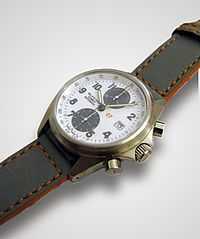Glycine watch


Glycine is a Swiss wristwatch manufacturer. Glycine became a noteworthy watch maker in the early 1950s for the introduction of their Airman model, a 24 hour watch favored by both military and commercial pilots. The Airman was worn by many United States Air Force pilots during the Vietnam War. Glycine still makes several variants of the Airman. Other models in the Glycine line include the Incursore, Combat, and Lagunare series.
History
The Beginning
Since its founding by Eugène Meylan in 1914, Glycine has been producing watches at its factory in Bienne, Switzerland.
Meylan was an uncompromising watch engineer who strove for perfection and nothing less. He had a profound understanding of both the market demands and the possibilities offered by the technological advances of the time. Very soon, he succeeded in producing extremely precise, small movements for ladies watches, enabling Glycine to put on the market the finest miniature movements, clad in precious gold and platinum cases, often studded with diamonds.
Glycine became a supplier to the wealthy people who valued highly these works of fine craftsmanship. However, Meylan did not stop there. Around 1931, he presented to the world market a well-functioning self-winding watch, entirely of his own invention, a sensational performance that, for lack of capital, could not be exploited commercially. Some of these GLYCINE Eugène Meylan SA self-winding watches can still be found in the collectors' market.
The year 1934 saw the launch of a chronometer range, a line of watches passing the exacting tests of the Official Swiss Quality Control. The depression years of the 1930s and the approaching world war took a heavy toll on the company as Switzerland was cut off from nearly all its traditional export markets.
Yet Glycine survived and even managed to be one of only 29 exhibitors at the Basel Fair in 1938, an annual event the firm has not missed since.
After World War II
In 1945, with the war over and access to world markets again possible, the industry took a deep breath.
Immediately, Glycine geared up production and rapidly presented a complete range of automatic (self-winding) watches, making use of the most advanced technologies.
1952 saw the birth of the famous VACUUM chronometers, watches known for their incredible resistance to water and shocks, designed for long-term use under hostile conditions. They performed well beyond expectations.
In 1953, the AIRMAN line was presented to the world market and immediately received an enthusiastic welcome. Now, in addition to regular local time, world time was available at a glance.
The steadily growing class of jet-setters and frequent travellers readily took to the convenience of having two time zones on their wrist.
The AIRMAN line has never been absent from the Glycine selection, and is, today more than ever, the spearhead of the range.
The Crisis
In the 1970s, the Swiss watch industry – late in introducing quartz movements - was hit by the proliferation of quartz watches from the Far East.
The technological revolution brought about by the quartz movement, together with the worldwide recession and a massive increase in value of the Swiss franc, pushed many manufacturers to the brink of disaster.
The products that had earned Glycine such an excellent reputation, namely high-quality mechanical watches and above all automatic watches, were suddenly no longer in general demand. Customers everywhere were buying Japanese quartz watches or American digital LED watches. The lucrative business with highly regarded automatic watches was over, and these were now being sold off at give-away prices.
The market went through a turnaround in its values, a tendency which further intensified as the price for the initially exorbitantly expensive quartz watches consistently dropped to a level where it finally drove even the cheap pin-pallet (Roskopf) mechanical movements out of the market. Many market shares were lost, the industry entered into a crisis that lasted six years and cost roughly 60,000 jobs.
Glycine too suffered heavily but managed to survive. In 1984, soldiering on with a reduced staff, Glycine was sold to Hans Brechbühler, who had been working for years with Glycine in a loose cooperation based on the joint development and exchange of watch models.
The Come-Back
Following the purchase of Glycine in 1984, Brechbühler, who had been a specialist in private label business, switched over to the brand watch business, an entirely new experience for him. Progressively, new products were developed that enabled Glycine to work successfully in countries such as Scandinavia, Italy, Holland, Belgium and Germany.
A quartz collection was created and an international network of agencies sprang to life again. Extremely resistant watches, such as the TJALK and HEAVY DUTY models, were launched and added to the prestige of the brand.
The market accepted with pleasure the GOLDSHIELD line, featuring a standard of goldplating much higher than anything the competitors could present. The sophisticated super-thin AMARANTH watches received an enthusiastic welcome in Italy and the USA.
The new strategies began to pay off in the early 1990s when Brechbühler's daughter Katherina, born in 1962, joined the company and successfully implemented her own brand concept, resulting in mechanical products being increasingly integrated into the company’s collections. This strategy proved effective in positioning Glycine as a specialist, with a long tradition in the field of mechanical watches.
After an initial success in Germany, the first to really accept the mechanical watches on a large scale, the new range of Glycine products spread to other countries.
External links
- Official website of Glycine Watch SA